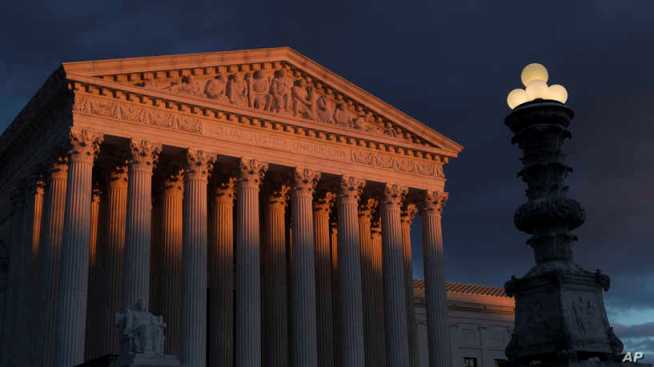Justices Taking up Bans on State Money to Religious Schools

Supreme Court Federal Death Penalty
VOA News By AP
WASHINGTON – A Supreme Court that seems more favorable to religion-based discrimination claims is set to hear a case that could make it easier to use public money to pay for religious schooling in many states.
The justices will hear arguments Wednesday in a dispute over a Montana scholarship program for private K-12 education that also makes donors eligible for up to $150 in state tax credits. Advocates on both sides say the outcome could be momentous because it could lead to efforts in other states to funnel taxpayer money to religious schools.
Montana is among 37 states that have provisions in their state constitutions that bar religious schools from receiving state aid.
The Legislature created the tax credit in 2015 for contributions made to certain scholarship programs for private education. The state’s highest court had struck down the tax credit as a violation of the constitutional ban. The scholarships can be used at both secular and religious schools, but almost all the recipients attend religious schools.
Kendra Espinoza of Kalispell, Montana, the lead plaintiff in the Supreme Court case, said the state court decision amounts to discrimination against her religious freedom. “They did away with the entire program so that no one could use this money to send their kids to a religious school,” said Espinoza, whose two daughters attend the Stillwater Christian School in Kalispell, near Glacier National Park.
She said she could not afford to keep her daughters enrolled without financial aid from the school, where tuition this year is $7,735 for elementary and middle school and $8,620 for high school. But Espinoza said she has never received money from the scholarship program and only began the application process late last year.
For Randi Weingarten, president of the American Federation of Teachers, the Montana program is part of a nationwide, conservative-backed campaign against public schools. “This is a ruse to siphon off money from public education,” Weingarten said. Teacher unions generally oppose school choice programs.
Montana is one of 18 states that offer scholarship tax-credit programs, according to EdChoice, an organization that promotes school-choice programs. Most have more generous tax credits, one of several ways states have created programs to boost private schools or defray their tuition costs. Others include vouchers, individual tax credits or deductions and education savings accounts.
“These programs are about empowering parents, low-income parents, to make the same educational choices that their well-to-do peers make every day, which is to choose private schools for their kids, if public schools aren’t working for them,” said Richard Komer of the Virginia-based Institute for Justice, which backs school choice programs. Komer represents the Montana parents at the Supreme Court.
When the Montana Supreme Court considered the scholarship program, it found that allowing public money to flow to religious schools, even indirectly, ran afoul of the state constitution. But rather than leave the program in place for secular schools, the court struck it down altogether. The state court ruling has been put on hold pending a Supreme Court decision.
The state hoped the wholesale invalidation of the program would shield it from Supreme Court review. In urging the Supreme Court to reject the case, Montana said it can’t be compelled to offer a scholarship program for private education. The state told the justices that the Montana court decision did not single out students at religious schools because the state court ruling struck down the entire program.
But at least four justices, the minimum needed to hear a case, were not persuaded by that reasoning. The Trump administration, which is taking steps to give religious organizations easier access to federal programs, has now joined the case on the parents’ side. This past week, President Donald Trump also pledged to protect prayer in public schools as part of his bid to solidify his evangelical base for the 2020 election.
Recent rulings from the Supreme Court, which now includes Trump appointees Neil Gorsuch and Brett Kavanaugh, in favor of religion-based discrimination claims suggest the state has an uphill fight. In 2014, the justices allowed family-held for-profit businesses with religious objections to get out from under a requirement to pay for contraceptives for women covered under their health insurance plans. In 2017, the court ruled for a Missouri church that had been excluded from state grants to put softer surfaces in playgrounds.
The Supreme Court also has upheld some school voucher programs and state courts have ratified others. But other state courts have relied on constitutional provisions banning the allocation of public school funds to religious institutions to strike down school choice programs.
The language in Montana’s constitution is itself under attack in the case being argued Wednesday. Lawyers for the parents and legal groups supporting them argue that anti-Catholic bias motivated the adoption of the Montana provision and similar measures in other states in the late 1800s. They are similar to the proposed 1875 Blaine Amendment to the U.S. Constitution that would have prohibited the allocation of public school funds to religious institutions.
But Montana and its supporters dispute that bigotry was behind the adoption the state’s “no-aid” clause in 1889. In any event, they contend, the provision is a part of the Montana Constitution that was adopted at a state constitutional convention in 1972, where one of the delegates who voted for it was a Catholic priest.
It’s unfair to label the convention delegates and Montana voters who later ratified the constitution as “mere rubber-stampers of bigotry,” the state wrote in its Supreme Court brief.
The Stillwater Christian School, like most Montana schools in the scholarship program, is not Catholic.
Espinoza said she chose it for her daughters, now 11 and 14, because “I really wanted values-based education for them, taught from the Bible, because that’s what we do at home.”

